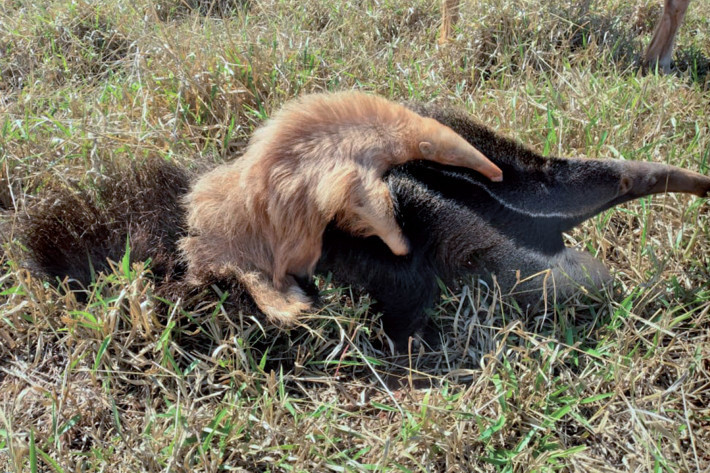Color abnormalities in the Giant Anteater (Myrmecophaga tridactyla Linnaeus, 1758) and Southern Tamandua (Tamandua tetradactyla [Linnaeus, 1758]) from Brazil and Ecuador
DOI:
https://doi.org/10.31687/SaremNMS22.11.2Palavras-chave:
América do Sul, leucismo, Myrmecophagidae, Pilosa, XenarthraResumo
Anomalias genéticas que resultam em alteração de coloração não são frequentes em Xenarthra e poucos registros foram descritos até o momento. Aqui relatamos o primeiro registro conhecido dessa alteração cromática em Myrmecophaga tridactyla e novos registros dessas alterações para Tamandua tetradactyla na América do Sul. Trazemos também um registro publicado online em um jornal local e discutimos alguns dos problemas inerentes a essas condições.
Referências
Abreu, M. S. L., R. Machado, F. Barbieri, N. S. Freitas, & L. R. Oliveira. 2013. Anomalous colour in Neotropical mammals: a review with new records for Didelphis sp. (Didelphidae, Didelphimorphia) and Arctocephalus australis (Otariidae, Carnivora). Brazilian Journal of Biology 73:185–194. https://doi.org/10.1590/S1519-69842013000100020.
Carden, S. M., R. E. Boissy, P. J. Schoettker, & W. V. Good. 1998. Albinism: modern molecular diagnosis. British Journal of Ophthalmology 82:189–195. http://dx.doi.org/10.1136/bjo.82.2.189.
Caro, T. 2005. The adaptive significance of coloration in mammals. BioScience 55:125–136. https://doi.org/10.1641/0006-3568(2005)055[0125:TASOCI]2.0.CO;2.
Gaudin, T. J., P. Hicks, & Y. Di Blanco. 2018. Myrmecophaga tridactyla (Pilosa: Myrmecophagidae). Mammalian Species 50:1–13. https://doi.org/10.1093/mspecies/sey001.
Landis, M. B., et al. 2020. First record of albino lowland tapirs (Tapirus terrestris Linnaeus, 1758) in an important Brazilian Atlantic Forest hotspot. Mammalia 84:601–604. https://doi.org/10.1515/mammalia-2019-0084.
Lapergola, J. B. 2019. First Record of Albinism in the Nine-banded Armadillo (Dasypus novemcinctus). Caribbean Naturalist 64:1–5.
Mahabal, A., R. M. Sharma, R. N. Patil, & S. Jadhav. 2019. Colour aberration in Indian mammals: a review from 1886 to 2017. Journal of Threatened Taxa 1:13690–13719. https://doi.org/10.11609/jott.3843.11.6.13690-13719.
Manchester, A., & W. Jorge. 2009. Biological data of a population of sloths (Bradypus variegatus) in a square of Teófilo Otoni, Minas Gerais, Brazil. Naturalia 32:81–86.
Miranda, F., A. Bertassoni, & A. M. Abba. 2014. Myrmecophaga tridactyla. The IUCN Red List of Threatened Species 2014:e.T14224A47441961. https://dx.doi.org/10.2305/IUCN.UK.2014-1.RLTS.T14224A47441961.en.
MMA. 2014. Portaria Nº 444, de 17 de Dezembro de 2014. <http://www.ibama.gov.br/sophia/cnia/legislacao/MMA/PT0444-171214.pdf>.
Mccardle, H. 2012. Albinism in wild vertebrates. Master Thesis. Texas State University at San Marcos, San Marcos, Texas, USA.
Menegaux, A. 1902. Catalogue de Mammifères rapportés par M. Geay, de la Guyane Française, en 1889 et 1900. Bulletin du Muséum National d'Histoire Naturelle de Paris 8:490–496.
Montgomery, G. G. 1985. Movements, foraging and food habits of the four extant species of Neotropical vermilinguas (Mammalia: Myrmecophagidae). The evolution and ecology of armadillos, sloths, and vermilinguas (G. G. Montgomery, ed.). Smithsonian Institution Press, Washington, D.C.
More, A., J. Vallejos, I. Sánchez, J. Vallejos, R. P. Piana, & R. D. Appleton. 2021. Registro de coloración anormal del oso hormiguero norteño Tamandua mexicana (Saussure, 1860) y notas sobre su límite sur de distribución. Revista Peruana de Biología 28:e19759. https://doi.org/10.15381/rpb.v28i1.19759.
Novaes, R. L. M. 2020. Melanism in Bradypus variegatus (Pilosa, Bradypodidae). Notas Sobre Mamíferos Sudamericanos 2:e20.0.37. https://doi.org/10.31687/saremNMS.20.0.37.
Ohana, J.A.B., et al. 2015. Avaliação do Risco de Extinção dos Xenartros Brasileiros. Instituto Chico Mendes de Conservação da Biodiversidade (ICMBio), Brasília.
Parsons, G. J., & S. Bonderup-Nielsen. 1995. Partial albinism in an island population of meadow voles, Microtus pennsylvanicus, from Nova Scotia. Canadian Field Naturalist 109:263–264. https://doi.org/10.31687/saremNMS.20.0.37.
Peña-Mondragón, J. L., E. Peña-Cuéllar, F. J. Hinojosa, & A. Sánchez. 2018. First confirmed record of an albino raccoon Procyon lotor for México. Galemys 30:71–73.
Ríos, A. S. D., B. C. R. Díaz, & C. P. Smith. 2019. Reporte de un ejemplar albino de Tamandua tetradactyla (Linnaeus, 1758) (Pilosa, Myrmecophagidae) en el suroeste de Paraguay. Edentata 20:35–38. https://doi.org/10.15560/6.1.052.
Ríos-Alvear, G., & H. Cadena-Ortiz. 2019. Records of melanistic Tamandua tetradactyla (Pilosa, Myrmecophagidae) from Ecuador. Neotropical Biology and Conservation 14:339–347.
Rosa, C. A., Q. Hobus, & A. Bager. 2010. Mammalia, Pilosa, Myrmecophagidae, Tamandua tetradactyla (Linnaeus, 1758): Distribution extension. Check List 6:052–053. https://doi.org/10.15560/6.1.052.
Shaw, J. H., J. Machado-Neto, & T. S. Carter. 1987. Behavior of free-living giant anteaters (Myrmecophaga tridactyla). Biotropica 19:255–259. https://doi.org/10.2307/2388344.
Tavares, M. S., L. S. Aguiar, C. H. Salvador, & M. Galliez. 2019. Beyond the color: the implications of pigmentation polymorphism in the activity behavior of a Neotropical squirrel. Mammalia 84:294–298.
Uieda, W. 2000. A review of complete albinism in bats with five new cases from Brazil. Acta Chiropterologica 2:97–105. https://doi.org/10.4236/ojas.2014.45037.
Xavier, G. A. A., M. A. B. Oliveira, A. A. Quirino, & R. A. Mota. 2010. Albinismo total em preguiças-de-garganta-marrom Bradypus variegatus (Schinz, 1825) no Estado de Pernambuco, Brasil. Edentata 11:1–3.
Wetzel, R. M. 1985. The identification and distribution of recent Xenarthra (= Edentata). The evolution and ecology of sloths, armadillos and vermilinguas (G. G. Montgomery, ed.). Smithsonian Institution Press, Washington.

Downloads
Publicado
Como Citar
Edição
Seção
Licença
Copyright (c) 2022 Daniela Bôlla, João P. Baraldo-Mello, Thierry Garcia, Sean Rovito

Este trabalho está licenciado sob uma licença Creative Commons Attribution-NonCommercial 4.0 International License.

